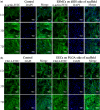Decellularized small intestine submucosa/polylactic-co-glycolic acid composite scaffold for potential application in hypopharyngeal and cervical esophageal tissue repair
- PMID: 33738114
- PMCID: PMC7955713
- DOI: 10.1093/rb/rbaa061
Decellularized small intestine submucosa/polylactic-co-glycolic acid composite scaffold for potential application in hypopharyngeal and cervical esophageal tissue repair
Abstract
There has been an increase in the incidence of hypopharyngeal and cervical esophageal cancer worldwide, and hence growing needs for hypopharyngeal and cervical esophageal tissue repair. This work produced a bi-layer composite scaffold with decellularized small intestine submucosa and polylactic-co-glycolic acid, which resembled the layered architectures of its intended tissues. The decellularized small intestine submucosa contained minimal residual DNA (52.5 ± 1.2 ng/mg) and the composite scaffold exhibited satisfactory mechanical properties (a tensile modulus of 21.1 ± 4.8 MPa, an ultimate tensile strength of 14.0 ± 2.9 MPa and a failure strain of 26.9 ± 5.1%). The interactions between cells and the respective layers of the scaffold were characterized by CCK-8 assays, immunostaining and Western blotting. Desirable cell proliferation and phenotypic behaviors were observed. These results have provided an important basis for the next-step in vivo studies of the scaffold, and bode well for its future clinical applications.
Keywords: composite scaffold; hypopharyngeal and cervical esophageal cancer; polylactic-co-glycolic acid; small intestine submucosa; tissue repair.
© The Author(s) 2021. Published by Oxford University Press.
Figures





Similar articles
-
SIS/aligned fibre scaffold designed to meet layered oesophageal tissue complexity and properties.Acta Biomater. 2019 Nov;99:181-195. doi: 10.1016/j.actbio.2019.08.015. Epub 2019 Aug 22. Acta Biomater. 2019. PMID: 31446049
-
Decellularized bovine small intestinal submucosa-PCL/hydroxyapatite-based multilayer composite scaffold for hard tissue repair.Mater Sci Eng C Mater Biol Appl. 2019 Jan 1;94:788-797. doi: 10.1016/j.msec.2018.10.011. Epub 2018 Oct 2. Mater Sci Eng C Mater Biol Appl. 2019. PMID: 30423765
-
Evaluation of decellularization protocols for production of tubular small intestine submucosa scaffolds for use in oesophageal tissue engineering.Acta Biomater. 2014 Dec;10(12):5043-5054. doi: 10.1016/j.actbio.2014.08.024. Epub 2014 Aug 27. Acta Biomater. 2014. PMID: 25173840
-
Tissue engineering technologies: just a quick note about transplantation of bioengineered donor trachea and augmentation cystoplasty by de novo engineered bladder tissue.G Chir. 2009 Nov-Dec;30(11-12):514-9. G Chir. 2009. PMID: 20109384 Review.
-
Development and Prospect of Esophageal Tissue Engineering.Front Bioeng Biotechnol. 2022 Feb 17;10:853193. doi: 10.3389/fbioe.2022.853193. eCollection 2022. Front Bioeng Biotechnol. 2022. PMID: 35252159 Free PMC article. Review.
Cited by
-
Recent advances in regenerative biomaterials.Regen Biomater. 2022 Dec 5;9:rbac098. doi: 10.1093/rb/rbac098. eCollection 2022. Regen Biomater. 2022. PMID: 36518879 Free PMC article. Review.
-
Bioengineered Approaches for Esophageal Regeneration: Advancing Esophageal Cancer Therapy.Bioengineering (Basel). 2025 Apr 30;12(5):479. doi: 10.3390/bioengineering12050479. Bioengineering (Basel). 2025. PMID: 40428100 Free PMC article. Review.
-
Safety and tissue remodeling assay of small intestinal submucosa meshes using a modified porcine surgical hernia model.Sci Rep. 2024 Jan 3;13(1):23108. doi: 10.1038/s41598-023-50425-5. Sci Rep. 2024. PMID: 38172186 Free PMC article.
-
Biaxial stretching of polytetrafluoroethylene in industrial scale to fabricate medical ePTFE membrane with node-fibril microstructure.Regen Biomater. 2023 Jun 2;10:rbad056. doi: 10.1093/rb/rbad056. eCollection 2023. Regen Biomater. 2023. PMID: 37397871 Free PMC article.
References
-
- Bradley PJ. Epidemiology of hypopharyngeal cancer. Adv Otorhinolaryngol 2019;83:1–14. - PubMed
-
- Sinha P, Haughey BH. Cancer of the Hypopharynx and Cervical Esophagus. 2016. https://oncohemakey.com/cancer-of-the-hypopharynx-and-cervical-esophagus....
-
- Kuppan P, Sethuraman S, Krishnan UM. In vitro co-culture of epithelial cells and smooth muscle cells on aligned nanofibrous scaffolds. Mater Sci Eng C Mater Biol Appl 2017;81:191–205. - PubMed
LinkOut - more resources
Full Text Sources
Other Literature Sources

